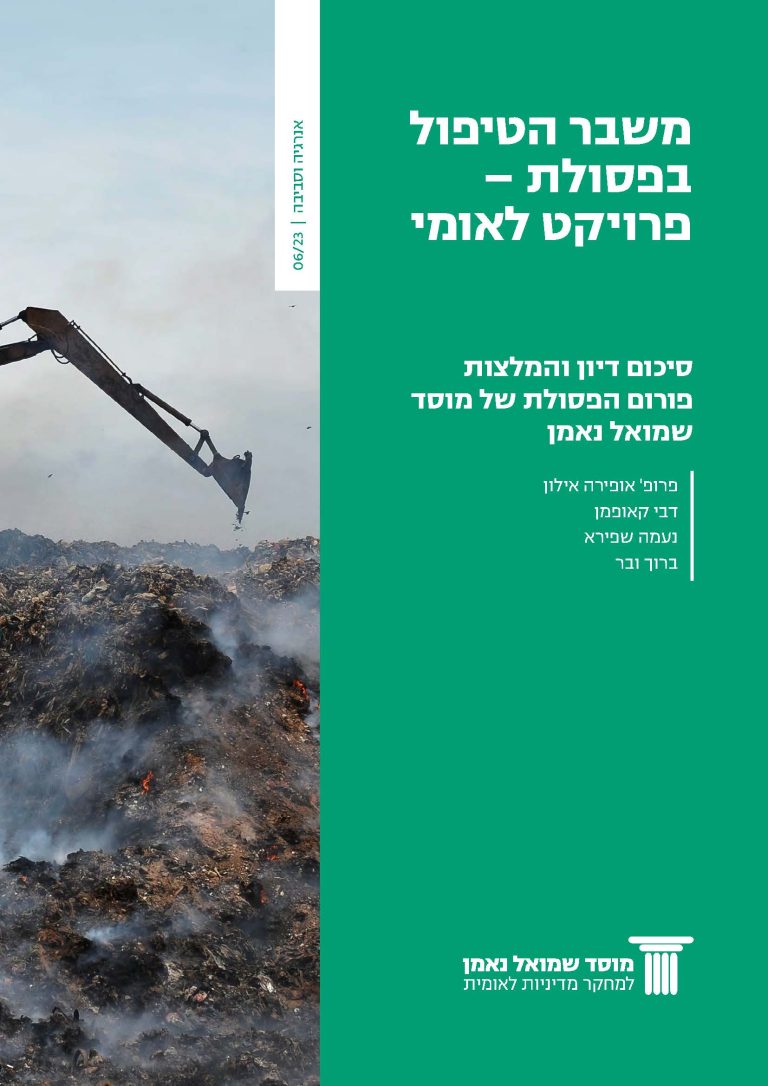In recent years, the State of Israel has reached a serious waste crisis. Already in the State Comptroller’s reports published in 2021 and 2022, and in the Israeli PRTR (mandatory reporting on emissions) published in recent years, it was possible to identify a problem due to the emission of carcinogenic substances and greenhouse gases – mainly methane, emitted from landfills and uncontrolled waste burning in open spaces.
Moreover, Israel’s position in diverse environmental benchmarks further suggests that the country lags in terms of environmental stewardship. For instance, Israel is ranked a mere 57th in the EPI index, which is widely recognized and utilized by the OECD and other global entities for evaluating various environmental indicators. Notably, Israel’s ranking falls below that of considerably less developed nations such as Namibia, Bulgaria, Romania, and others. Israel’s position on the vitality of its ecosystem policy and the overall environmental ecosystem, encompassing water resources, agriculture, and various environmental services, is situated at a disappointing 98th place.
According to the Central Bureau of Statistics, in 2017 the amount of waste generated in Israel amounted to approximately 20.9 million tons. The annual waste is distributed as follows: about 8.2 million tons of dry waste, about 6.8 million tons of mixed waste, about 5.5 million tons of agricultural waste, about 0.3 million tons of hazardous waste and about 0.1 million tons of sludge. About 45% of the waste is generated in households and commerce (5.4 million tons) and industry (3.9 million tons).
In 2019, about 5.8 million tons of municipal solid waste were produced in Israel, with over 40% of it produced in the Central and Tel Aviv districts. The national waste composition survey 2012-2013 shows that the municipal waste in the collection trucks consists of 32% food scraps, 22% paper and cardboard, 17% plastic and 29%.
The national waste composition survey 2012-2013 Waste conducted in 2013 by the Shaf company and the Ministry of Environmental Protection, in 27 municipalities, shows that the municipal waste in the compactor trucks consists of 32% food scraps, 22% paper and cardboard, 17% plastic and “others” comprise 29% of the waste.
Between the years 2007 (the year the landfill tax was imposed) and 2022, substantial disparities are evident between the policy set by the Ministry of Environmental Protection regarding solid waste management and the actual performance and measures implemented within the country. (For more information: see here)
Therefore, the topic of waste treatment in Israel, without a doubt, requires immediate action, as it is a ticking time bomb.
From the conclusions of the discussion of the SNI waste forum held, as mentioned, on the basis of the document “The crisis of handling waste in Israel is more urgent than the handling of the climate crisis”, a prominent central issue emerged- the need to construct and operate facilities for waste management.
The following recommendations are as follows:
- The definition of waste management as a national project – this national project will include the participation of all stakeholders in the waste market, a budget management mechanism, initiation, and establishment of waste treatment facilities (Sorting facilities, recycling, waste to energy and alike)
- Separating the discussion on the climate crisis from waste management- dealing with the climate issue should not delay the treatment of waste, and certainly not those who are entrusted with it. Although waste management are included in the same category due to the two-sided effect of these two issues, there is a moral and environmental obligation to create a separation between the two topics, in order to promote urgent waste management facilities.
- Establishing a body (an authority or directorate) that will be authorized to manage waste management – it is proposed to establish a joint directorate of the Ministry of Environmental Protection and the local government for waste management, like the water authority and the water and sewerage corporations (or another model that will be examined and found appropriate). Consideration should also be given to including waste management entities, such as the Dan Cities Association (that operates the Hiriya recycling park) and Dudaim sorting and landfill facility, which are partially owned by local authorities. The directorate will prepare a multi-year plan, including key performance indicators, for the implementation of the policy set by the Ministry of Environmental Protection (and the Government in general), and for the benefit of the local authorities’ compliance with the responsibility for handling waste. The policy will also be carried out by mutual agreements, and in accordance with the multi-year plan. Like the water and sewage corporations, the directorate will consist of professionals in the field, engineers and economists who will outline a long-term policy. The Ministry of Environmental Protection, similar to the Ministry of Energy and Infrastructure in relation to the water and sewage corporations, will be the regulator.
- Closed market for waste management – The administration’s budgets will come from two main sources – the regional waste corporations will collect the funds of waste treatment from the local authorities (dedicated payments for waste treatment, through a direct payment for the waste produced, and not as part of the property tax). Another source will be the landfill tax funds that are currently in the fund for maintaining cleanliness, in a way that will ensure that the funds are used for the purpose for which it was established- promoting waste reduction (via campaigns, incentives to the industry and households to reduce waste) and waste management facilities. Thanks to excellent opening conditions of funds in the cleanliness maintenance fund, as well as annual revenues of ove 600 million NIS, there is a possibility of immediate application of the process.
- Long-term waste policy – a long-term thinking for waste is needed, and therefore it is proposed that the management of waste be introduced for at least 20 years ahead, to enable stability and the construction of facilities with large investments, for example in BOT or PPP models that will allow the waste market to be promoted.
It is important to note that issues such as reducing the source, adapting the solution to the “watershed” (applying the principle of proximity), transportation distances, and more, are beyond the scope of the discussion, but must be taken into account in formulating the overall solution, and as part of the multi-year plan that the waste management must prepare.












